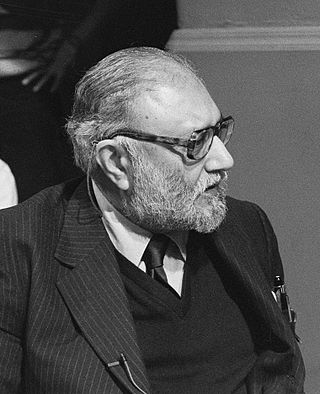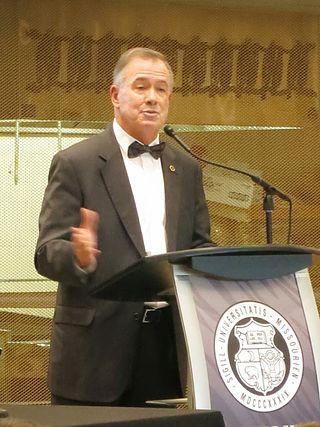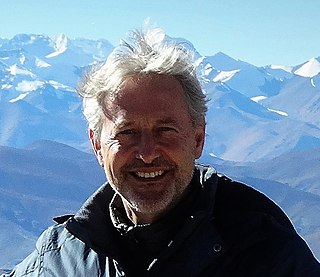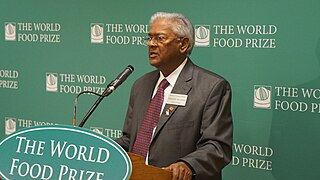
The Green Revolution, or the Third Agricultural Revolution, was a period of technology transfer initiatives that saw greatly increased crop yields. These changes in agriculture began in developed countries in the early 20th century and spread globally until the late 1980s. In the late 1960s, farmers began incorporating new technologies such as high-yielding varieties of cereals, particularly dwarf wheat and rice, and the widespread use of chemical fertilizers, pesticides, and controlled irrigation.

Norman Ernest Borlaug was an American agronomist who led initiatives worldwide that contributed to the extensive increases in agricultural production termed the Green Revolution. Borlaug was awarded multiple honors for his work, including the Nobel Peace Prize, the Presidential Medal of Freedom and the Congressional Gold Medal, one of only seven people to have received all three awards.

A land-grant university is an institution of higher education in the United States designated by a state to receive the benefits of the Morrill Acts of 1862 and 1890, or a beneficiary under the Equity in Educational Land-Grant Status Act of 1994. There are 57 institutions which fall under the 1862 Act, 19 under the 1890 Act, and 35 under the 1994 Act.

The International Maize and Wheat Improvement Center is a non-profit research-for-development organization that develops improved varieties of wheat and maize with the aim of contributing to food security, and innovates agricultural practices to help boost production, prevent crop disease and improve smallholder farmers' livelihoods. CIMMYT is one of the 15 CGIAR centers. CIMMYT is known for hosting the world's largest maize and wheat genebank at its headquarters in Mexico.
Catherine Bertini is an American public servant. She is the 2003 World Food Prize Laureate. She was the Executive Director of the United Nations World Food Program from 1992 to 2002. She served as the UN Under-Secretary for Management from 2003 to 2005. Currently she is a distinguished fellow at the Chicago Council on Global Affairs, the Chair of the Board of the Global Alliance for Improved Nutrition (GAIN) and the Chair of the Executive Board of the Crop Trust.

Melville Peter McPherson is president emeritus of the Association of Public and Land-grant Universities. He previously served as a special assistant to President Gerald Ford, administrator of USAID under President Ronald Reagan, Deputy Secretary of the U.S. Department of Treasury, President of Michigan State University from 1993 to 2004, and Chairman of Dow Jones.

Science and technology is a growing field in Pakistan and has played an important role in the country's development since its founding. Pakistan has a large pool of scientists, engineers, doctors, and technicians assuming an active role in science and technology. The real growth in science in Pakistan occurred after the establishment of the Higher education Commission in 2002 which supported science in a big way and also became the major sponsor of the Pakistan Academy of Sciences under the leadership of Prof. Atta-ur-Rahman. The emphasis was placed on quality rather than numbers during this period. The quality measures introduced by Prof. Atta-ur-Rahman as Founding Chairman HEC included:1) All Ph.D. thesis were evaluated by eminent foreign scientists,2) All PhD theses and research papers were checked for plagiarism 3) Some 11,000 students were sent abroad to leading universities for PhD level training and absorbed on their return, 4) Appointments at faculty positions were linked to international stature of the applicants as judged from their international publications, patents and citations, and (5) Quality Enhancement Cells were established in all universities for the first time in the history of the country. (6) The minimum criteria for establishment of a new university were approved by the Cabinet and universities that did not meet these criteria were closed down. (7) The Model University Ordinance was approved setting the governance parameters for new universities. (8) A list of fake higher education institutions was prepared and made public. (9) Quality Assurance Agency (QAA) was set up within the Higher Education Commission that established Quality Enhancement Cells (QECs) as its operational units in public and private-sector universities across the country. (10) The funding of universities was linked to excellence in teaching and research under a formula based funding mechanism that considered enrolment, subjects and quality of teaching and research. The first IT policy and implementation strategy was approved under the leadership of Prof. Atta-ur-Rahman, then Federal Minister of Science & technology, in August 2000 which laid the foundations of the development of this sector On the request of Prof. Atta-ur-Rahman, Intel initiated a nationwide programme to train school teachers in Information and Communication technologies in March 2002 which has led to the training of 220,000 school teachers in 70 districts and cities across Pakistan. A 15-year tax holiday was approved on the recommendation of Prof. Atta-ur-Rahman which has resulted in growth of IT business from $30 million in 2001 to over $3 billion. The Pakistan Austria University of Applied Engineering (Fachhochschule) has been established in Haripur Hazara under a Steering Committee Chaired by Prof. Atta-ur-Rahman in which students will get degrees from several Austrian universities. Pakistan's growth in scientific output can be seen from the fact that in 1990 Pakistan published 926 scholarly documents while in 2018 the number rose to 20548, a twenty times increase.In contrast India published 21443 scholarly documents in 1990 and the number rose to 171356 in 2018, an eight times increase. In 2018, 336 people per million were researchers in the R&D in Pakistan compared to 256 people per million being researchers in India. The reforms begun by Prof. Atta-ur-Rahman FRS in 2003-2008 have continued over the subsequent decade and according to the Web of Science report, there was a 300% growth in research publications in 2019 over the decade, with 2019 marking the first year in which Pakistan was ranked above the world average in research. In 2019, Pakistan produced 300% more publications indexed in the Web of Science Core Collection than in 2010. In the decade of 2010-2019, more than half of Pakistan’s research was published in journals with Impact Factor. The global influence of Pakistan’s research is increasing as scientists in the country are publishing more in top quartile journals. The Category Normalized Citation Impact of Pakistan’s publications has risen from 0.67 to 1.03. output. As of 2020, Pakistan has 85% tele density with 183 million cellular, 98 million 3G/4G and 101 million broadband subscribers, due to the foundations laid by Prof. Atta-ur-Rahman of the IT and telecom industry during 2000-2008. In an analysis of scientific research productivity of Pakistan, in comparison to Brazil, Russia, India and China, Thomson Reuters has applauded the developments that have taken place as a result of the reforms introduced by Prof. Atta-ur-Rahman FRS, since Pakistan has emerged as the country with the highest increase in the percentage of highly cited papers in comparison to the "BRIC" countries
The Norman E. Borlaug International Symposium, commonly known as the Borlaug Dialogue, is an annual international symposium tackling the topic of global food security organized by The World Food Prize Foundation. Past symposia have focused on the promises and challenges presented by biofuels for global development, the dual challenges of malnutrition and obesity, water insecurity and its impact on development and stability in the Middle East, and the possibility of replicating the Green Revolution.

Brady J. Deaton, is an American educator and the former chancellor of the University of Missouri in Columbia, Missouri.
Jo Luck is an American and former CEO of Heifer International. She was recognized with a World Food Prize in 2010.

Patrick Webb serves as Chief Nutritionist for the United States Agency for International Development USAID. He was Dean for Academic Affairs at Tufts University's Friedman School of Nutrition from 2005 to 2014.
The Feed the Future Initiative (FTF) was launched in 2010 by the United States government and the Obama Administration to address global hunger and food insecurity. According to Feed the Future, it is "the U.S. government's global hunger and food security initiative."

The Cooperative State Research, Education, and Extension Service (CSREES) was an extension agency within the U.S. Department of Agriculture (USDA), part of the executive branch of the federal government. The 1994 Department Reorganization Act, passed by Congress, created CSREES by combining the former Cooperative State Research Service and the Extension Service into a single agency.

Dr. Sanjaya Rajaram was an Indian-born Mexican scientist and winner of the 2014 World Food Prize. He was awarded this prize for his scientific research in developing 480 wheat varieties that have been released in 51 countries. This innovation has led to an increase in world wheat production – by more than 200 million tons – building upon the successes of the Green Revolution. The Government of India awarded him India's fourth- and third-highest civilian awards Padma Shri (2001) and Padma Bhushan (2022).

Dmytro Melnychuk – Hero of Ukraine, academician of National Academy of Sciences and National Academy of Agrarian Sciences, professor (biochemistry), doctor of biological sciences, honored worker of science of Ukraine, state prize laureate in science and technology of Ukraine, Full Cavalier of Ukraine titles "For Merits", rector of the National University of Life and Environmental Sciences of Ukraine, professor of the department of biochemistry and the quality and safety of agricultural products NULES of Ukraine, member of the bureau of biochemistry, physiology and medical sciences of Ukraine, member section "Biology" of the state committee of Ukraine on awarding state prizes of Ukraine in science and technology, member of the scientific council of the world confederation of associations of higher agricultural education and life sciences, member of the agrarian party of Ukraine, chairman of the NGO "Council of Ukraine heroes in agriculture ", honored veteran of Kyiv.

Dilbagh Singh Athwal was an Indian-American geneticist, plant breeder and agriculturist, known to have conducted pioneering research in plant breeding. He was a professor and the Head of the Department of Plant Breeding at Punjab Agricultural University and an associate of Norman Borlaug, a renowned biologist and Nobel Laureate, with whom he has collaborated for the introduction of high-yielding dwarf varieties of wheat.
Jean Beagle Ristaino is an American scientist and William Neal Reynolds Distinguished Professor of Plant Pathology. She is best known for her work on the epidemiology and population genetics of Oomycete plant pathogens in the genus Phytophthora and her work on the population genomics of historic outbreaks of the Irish famine pathogen, Phytophthora infestans

Alison L. Van Eenennaam is a Cooperative Extension Specialist in the Department of Animal Science at the University of California, Davis and runs the Animal Genomics and Biotechnology Laboratory. She has served on national committees such as the USDA National Advisory Committee on Biotechnology in the 21st Century (AC21) and was awarded the 2014 Borlaug CAST Communication Award. Van Eenennaam writes the Biobeef Blog.
Hari Krishan Jain was an Indian cytogeneticist and plant breeder, known for his contributions to the field of genetic recombination and the control of interchromosome level. He is a former chancellor of the Central Agricultural University, Imphal, a former director of the Indian Agriculture Research Institute and a recipient of honours such as Rafi Ahmed Kidwai Award, Borlaug Award and Om Prakash Bhasin Award. The Council of Scientific and Industrial Research, the apex agency of the Government of India for scientific research, awarded him the Shanti Swarup Bhatnagar Prize for Science and Technology, one of the highest Indian science awards, in 1966, for his contributions to biological sciences. He received the fourth highest Indian civilian honor, the Padma Shri, in 1981.
Rattan Lal is a soil scientist. His work focuses on regenerative agriculture through which soil can help resolve global issues such as climate change, food security and water quality. He is considered a pioneer in soil-centric agricultural management to improve global food security and develop climate-resilient agriculture.













